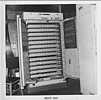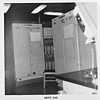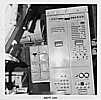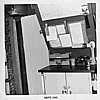the following series of articles appeared in
Volunteer Information Exchange
issues 2-13, 2-14, 2-15, 3-01
published by Jim Strickland < JLStrick @ aol . com >
a volunteer at the Computer History Museum
NTDS Computer Notes
by Robert Clinton < rhclinton @ tranquility . net >
Table of contents
- The NTDS Computer – Part 1 Vol 2 Num 13, Sept 15, 2013
- The NTDS Computer – Part 2 Vol 2 Num 14, Sept 30, 2013
- Programming under Fire Vol 2 Num 15, Oct 15, 2013
- NTDS on the USS King Vol 3 Num 1, Jan 5, 2013
Robert Clinton
|
Conversation with Robert Clinton
Lowell Klaisner In my first conversation with Robert Clinton in R|EVOLUTION, he told me that we had missed a significant computer in computer history, the C642. I was not familiar with the designation so heard him out. As he talked I realized he was talking about the computer in the NTDS or one like it, so I took him there. What ensued was a fun conversation about the computer and his experiences on the USS King. In the end, I asked him if he would be willing to write a few paragraphs about his experiences for our Volunteer Information Exchange. The result was the three articles that appear here and subsequent issues. |
The Museum’s Revolution exhibition celebrates “2,000 years of computing.” My own part in that history is much more brief but my recent visit did coincide with the 50th anniversary of my first contact with digital computers. I had been aware (from consulting your online catalog) that your collection contained an example of my first computer and in anticipation of my visit I sent an email enquiring if it was on display. I was disappointed to receive a reply telling me it was in “deep storage” and unavailable to view. So it was a great thrill for me to learn on arrival that it was indeed on display. I believe that the confusion arose from a variety of nomenclature associated with the machine.
The computer in question is labelled in your display as the NTDS Computer. This is quite accurate but the machine on display needs to be put in context.
NTDS stands for Naval Tactical Data System. This was the first shipboard system utilizing general purpose (as well as a lot of special purpose) digital technology. The Navy had used analog computers for years, primarily in gunfire control systems, but NTDS was the first system to use “1 and 0” technology. Although it was capable of performing a variety of functions, its primary use was controlling fighter aircraft in air combat. The first three ships to receive NTDS were the missile frigates USS King (DLG10) and USS Mahan (DLG11) and the aircraft carrier USS Oriskany (CVA34). Collectively they were known as the Service Test Ships. Some have observed that the hull numbers of King and Mahan could be interpreted as binary numbers. I suspect that this was merely coincidence and not the reason that these ships were selected to be the first recipients of NTDS.
The term NTDS was properly used to describe the entire shipboard installation, which was composed of three major subsystems. These subsystems, and their components, were each given designations within the Army/Navy (AN/) nomenclature structure. The subsystems were:
- The computer system proper – AN/USQ20. This subsystem was manufactured by Remington Rand Univac (later Sperry Univac)
- The display system (AN/SYA1), manufactured by Hughes Aircraft Corp. It mainly included display consoles which combined large radar PPI displays with digital symbols and data entry facilities. There were also various ancillary devices, particularly the digital symbol generator.
- The data transmission subsystems (AN/SSQ29), manufactured by Collins Radio Corporation. This equipment provided intership data communication utilizing the NATO Link11 protocol.
The software which ran on the CP642 was known as “the operational program” and it was primarily the tactical data system. There was no operating system as we understand the term today, though there was an embedded package of rudimentary functions that permitted inspecting memory and making changes. The original elements of the operational program were written in assembly language but for later versions Univac provided a higher level language known as CS1.
Programming was performed at two Fleet Computer Programming Centers, the first, located at the Naval Electronics Laboratory at Point Loma, San Diego and the second on the east coast, somewhere in Virginia , as I recall. Shipboard technicians were not expected to do any programming, but of course we did. Since we were not provided with an assembler nor with any reasonable means of input, we did all our programming in absolute machine code, punched into the maintenance panel one octal character at a time.
The operational program was available in two levels of capability which were designated in accordance with the Navy’s specification of levels of shipboard readiness. Condition 1 indicated maximum readiness (i.e., “battle stations”) and Condition 4 was routine peacetime sailing. Thus the Condition 1 level of the operational program was designed for operation with both (or all three, in the case of Oriskany) CPUs interconnected while the Condition 4 level provided a reduced set of capabilities running on only one machine. Running Condition 4 provided the ship with continued NTDS functions in the event of failure of one CPU or if routine maintenance was to be performed.
NTDS first went to sea in 1961 aboard the Service Test ships. These three ships engaged in extensive testing of NTDS off the coast of California and made two deployments to the far east. But in March 1965 they were sent to the Gulf of Tonkin as part of Operation Rolling Thunder, the bombing of North Vietnam. I contend that this was the first use of general purpose digital computers in combat operations. Of course, Colossus was used in wartime code breaking, but it was not in an actual combat zone (although some will maintain that all of Britain was a combat zone). The Air Force personnel who operated SAGE might reply that they were in the thick of the Cold War but, fortunately for the fate of mankind, the world never became an actual combat zone. But although the King, Mahan and Oriskany were not subject to hostile attack, there is no doubt that we were in a combat zone: we were given combat pay and were awarded the Vietnam Service Medal
There are two books that provide more details on the development and deployment of NTDS. I believe neither is currently in print but used copies are sometimes available:
David L. Boslaugh, When Computers Went to Sea: The Digitizaion of the United States Navy, IEEE Computer Society, 1999Throughout the museum the displays celebrate the accomplishments of the scientists and engineers who conceived and designed the devices of the computer age, and this is at it should be, for without this genius we would have no computers. But I would suggest that some recognition be given to the next lower echelon of expertise that from the start has been responsible for keeping the equipment operating and for assisting users and programmers in making productive use of it. These people have been known by a variety of titles: Field Service Engineer, Systems Engineer, Data Systems Technician, etc.David E Lundstrom, A Few Good Men from Univac, MIT Press, 1987
The initial set of NTDS technicians received their training at the Univac, Hughes and Collins factories but in mid1962 a Navy school was established at Mare Island Naval Shipyard in Vallejo, CA. I was in the first class to convene at this school and received 48 weeks of instruction before graduating to the USS King. After two and a half years on the King I returned to Mare Island as an instructor, primarily teaching the CP642. I taught the inner workings of the computer and its peripherals to aspiring technicians for three years and in Part 2 I will try to recall some of the things I remember about this equipment.
Richard Clinton's article will be continued in future editions of the VIE.
The NTDS Computer – Part 2 Vol 2 Num 14, Sept 30, 20
As I mentioned in Part 1, I taught the internals of the CP642 (“NTDS Computer”) for three years, and here is what I remember about it. These memories are at least 43 years old so they may not be entirely accurate – any corrections will be appreciated.
As improvements were introduced into NTDS the modified units were given a suffix to designate the new model. For example, there were CP642A and CP642B versions of the CPU. I believe that the example on display in the Museum is a factory prototype. Although it is in most respects the same as the machine I worked on aboard the USS King, there is a significant of difference: the shipboard model had the lights, buttons and switches of the maintenance panel inside the doors (see photo).
During my visit in August I was asked about the connectors on the front of each chassis. These were not connectors in the usual sense of having mating male connectors; they were actually sets of test points. The CP642 (and indeed all of the USQ20 devices) were lavishly supplied with test points – the output of each logic gate in the machine could be observed by inserting an oscilloscope probe into the associated test point. With a ‘scope and the large book of logic diagrams (known as a “surfboard”) troubleshooting the machine was very straightforward, though its reliability made this a relatively infrequent activity.
The immediate forerunner of the USQ20 was a machine designated USQ17. It was in many respects similar to the “Q20” but had a different I/O protocol and was not suitable for shipboard installation, though it did receive extensive use ashore in the development of NTDS. I believe that CP642 (no suffix) model only saw sea duty on the service test ships. Subsequent installations were of the CP642A. This machine was logically identical to the CP642 but had the maintenance panel mounted above the cabinet, obviating opening the doors to perform tests. The CP642B did have some changes to architecture, including a scratchpad memory.
The label on the Museum’s display accurately describes the computer’s salient characteristics: 9 microsecond add and 32K of 30 bit words. By today’s standards, pathetically underpowered but in 1962 it was “state of the art”, though that phrase was not as overworked in those days as it is now. The machine did have some characteristics that were well ahead of its time:
As can be seen in the example on display in the Museum, the chassis were actually large trays of connectors into which logic cards were plugged. The cards were about the size of a credit card and each contained a number of NOR gates (up to four, depending on the number of inputs) or one or two bistable elements. The cards were potted in epoxy and were designed to be thrown away if they failed. There were about 49 different types of cards and they were used in the Univac peripheral devices as well as in the CPU. The basic logic element was the NOR circuit. Since this circuit combined both the NOT and OR function, it could be combined to produce any more complex logic function. Two NOR circuits were combined to produce a
bistable (“flipflop”) element.
The adder circuit merits mention. It was variously described as a “1’s complement subtractive adder” or a “2’s complement additive adder”, but whatever you called it, it was a complex bit of logic circuitry which permitted its blistering 9 microsecond add speed. It used the concept of group carries to achieve its performance.
Consequently it was the most difficult part of the machine to explain and understand.
Connections to the logic and memory chassis were
through racks of connectors on either side of the chassis (not easily seen when observed from the front). When it was necessary to withdraw a chassis from the cabinet a socket wrench was used to disconnect the racks of connectors from the chassis. It was therefore not possible to operate the computer with a chassis withdrawn, which explains the need to have the test points available on the front of the chassis. The five memory chassis were identical and could be freely interchanged (as they sometimes were for diagnostic purposes) but each logic chassis had to be in its specified position.
At the right edge of each chassis there is a toggle switch labelled “Margins.” This allowed running a chassis during maintenance testing with either an increased or decreased DC supply voltage. A test which failed when running margins (usually the low ones) indicated a potential failure which merited further investigation.
The CPUs and the Univac peripherals required a 400 Hz mains supply in order to reduce the size of the DC supplies. This current was provided by either of two motor generators which ran from the ship’s 60 Hz supply. The CPUs and the larger peripherals were cooled by chilled water. Occasionally this supply was interrupted by an air block and within about 15 seconds the internal temperature would skyrocket and the system would
crash. Sometimes this caused a failure of one or more logic cards.
Although the computers were installed in air conditioned
interior spaces, the Navy did specify that they have “watertight integrity”, which explains the heavy doors with gear teeth. In normal operation these doors were kept closed and “dogged down” but they had to be opened when maintenance was necessary. There were braces to keep them open but opening and closing them when the ship was taking 40 degree rolls required considerable care. More than one Data Systems Technician – myself included – suffered “computer thumb”, but this injury did not earn us a Purple Heart, even when we were in a combat zone.
Robert Clinton
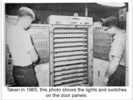 This has triggered a distant memory: in 1964 I spent two weeks at the Naval Electronics Lab at Point Loma and I now recall that a CP642 was controlled from a more conventional control panel, mounted in a desk. The machine may even have been the one in the Museum’s display.
This has triggered a distant memory: in 1964 I spent two weeks at the Naval Electronics Lab at Point Loma and I now recall that a CP642 was controlled from a more conventional control panel, mounted in a desk. The machine may even have been the one in the Museum’s display.
There was no online mass storage included in the system. The magnetic tape unit was used only for initial loading of the operational program and for writing diagnostic dumps. All code and data therefore had to reside in the core memory of the computers. A wired memory (literally, jumper wires) was available to bootstrap the computer from magnetic tape, paper tape or another computer.
Robert Clinton, a recent museum visitor wrote a three part article on his experiences on the USS King where he supported the NTDS system that is now on display at the CHM.
